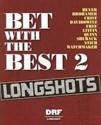
A Horse Racing Fan’s Guide to Holiday Movies and TV

I’ve read a lot of horse racing books over the years. I prefer the books about the history of racing and gambling, but today I’ll share with you some of the books about handicapping that I think helped my own game as I was learning how to bet the ponies.
The one caveat here is that, just as if you asked 10 people at the track what horse they like in a race, you’re likely to get a lot of different and conflicting opinions about this stuff.
If there was one correct way to bet on horses, everyone would do it and the game would be a lot tougher to win. I picked these books because of a combination of simple and sound advice and also my own personal preference for how I like to bet. It isn’t an exhaustive list, but a starting place for people looking to get into the sport and wanting something to read to teach them how to get better.
“Betting Thoroughbreds for the 21st Century” by Steve Davidowitz

This book is the handicapper’s bible. Davidowitz is one of the most thoughtful, intelligent minds in the sport, and he has continued to update this text over the past 30-plus years to reflect new information, technology, and thinking about the game.
Davidowitz tackles fundamental concepts like how to analyze class and how to manage your money and pick the right bets. The book is equally useful to beginners and experienced handicappers.
My original copy of the book was a gift at a bachelor party in Saratoga Springs, N.Y. It has both an inscription from the groom and an inscription from Davidowitz himself. It is, for many reasons, among my most prized possessions.
“Overlay, Overlay” by Bill Heller

This book is an important one for beginner horseplayers, though people who have been around the game for a while might find the concept of overlays to be pretty obvious.
For me, reading this book was a watershed event in understanding this game. The basic concept of this book is that it is sometimes better to bet on horses that have been underbet by the public relative to their chances of winning than it is to bet on the horse you think is the most likely to win the race. A horse that is underbet relative to its chances is an overlay, and a horse that is overbet and offers too little money to those who take a chance betting on them is an underlay.
Heller outlines some basic ways to evaluate horses and determine what you think their prices should be, and then he offers some betting strategies for taking advantage of the overlays you find. A quick read for beginners that should introduce you to what is essentially the first commandment of horse-race gambling.
“Exotic Betting” by Steven Crist

Good luck finding this book! It’s out of print and there are copies online selling for over a hundred dollars! If you can get your hands on a copy, it’s worth so much more than a hundred bucks. It can help you cash some big tickets.
This book doesn’t focus on how to choose winners. It assumes you already have your own method for doing that. Instead, this book details Crist’s strategy for playing multi-race exotic bets like Pick 4s and Pick 6s. He teaches you how to maximize the number of horses you can include on tickets while minimizing the cost of the ticket.
Crist also explains how to get more value out of the horses you feel best about versus the horses you are taking a flyer on. These kinds of bets are increasingly the bets that offer the horseplayer the best value - especially when big carryover pools put lots of “dead money” in the pot.
“Bet With the Best 2 - Longshots” by Various Authors

This book is a follow up to the popular book “Bet With the Best” (natch) and brings several of those handicappers back to discuss how to bet longshots. While “Bet With the Best” is a pretty good book, the reason I’m recommending this one is that I have gone back to the advice in this book many times at the track and have found it to be practical and effective.
I’m one of these gamblers (suckers) who is addicted to betting on longshots. I just can’t help trying to beat the favorite. Maybe, I just love a good underdog. Unfortunately, that preference has forced me to make a lot of idiotic bets in my life. This book helped me figure out how to channel some of that stupidity into actual smart, reasoned plays. And there’s no better feeling than being the only person who had the big longshot when it hits (and having a good reason why when everyone around you asks you “what did you like about that horse?”)
There are a number of other good handicapping books on my shelves, but these have stood out to me as formative and important. Next time, I’ll share some of my favorite horse racing nonfiction.